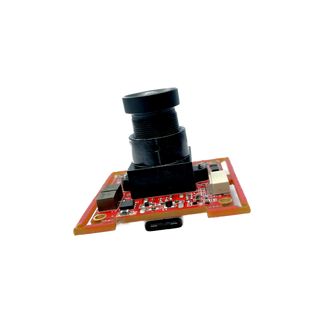Lens Features and Types: How to Choose the Right Lens for Embedded Cameras?
- Vadzo Imaging

- Feb 14, 2023
- 4 min read

When it comes to imaging performance, the camera lens features you choose often determine the overall quality of your results—sometimes even more than the camera sensor or body itself. In embedded camera systems, where space is limited and performance demands are high, lens selection becomes a crucial part of the design process.
While the camera body controls parameters like megapixels, shutter speed, and ISO sensitivity, it’s the lens that defines how light enters, what portion of the scene is captured, and how accurately it’s projected onto the sensor. A poor-quality lens can limit the capabilities of even the most advanced image sensor, while a well-matched lens can elevate image performance far beyond expectations.
Understanding the Role of Camera Lens Features in Embedded Systems
In embedded camera systems—such as those used in industrial automation, medical devices, robotics, or IoT security—camera lens features serve a dual role: they enable the desired imaging function and ensure optical performance in challenging, application-specific environments.
The right lens will optimize:
Light capture efficiency for low-light or high-speed scenarios.
Field of View (FOV) to cover exactly what’s needed—no more, no less.
Distortion control to maintain accuracy in measurements or object recognition.
Focus precision to ensure clear and usable imagery.
Ignoring these aspects can lead to blurred results, poor low-light performance, or inconsistent output across conditions.
Anatomy of an Embedded Camera Lens
To make informed decisions, you first need to understand the main camera lens features that make up an embedded optical system:
Lens Elements – Multiple pieces of precision-shaped glass or plastic that bend and focus light onto the sensor. Advanced designs include aspherical elements to reduce spherical distortion and chromatic aberration.
Aperture Mechanism – Controls the amount of light passing through. In embedded designs, this may be fixed for simplicity or adjustable for exposure control.
Focus Mechanism – Can be manual (fixed focus) or automatic (autofocus). Autofocus is vital for dynamic use cases like autonomous vehicles or moving subjects.
Optical Coatings – Thin layers applied to lens surfaces to reduce reflections, improve contrast, and increase light transmission efficiency.
Mounting System – Mechanical and sometimes electrical interface that connects the lens to the camera module. In embedded systems, C-mount, CS-mount, and custom mounts are common.
Each of these camera lens features can be tuned for application-specific needs—something that becomes critical when space, cost, or environmental conditions are restrictive.
Key Camera Lens Features for Embedded Applications
Embedded systems have unique requirements that make certain camera lens features more important than others:
Compact Size – Lenses must fit within constrained designs like drones, wearables, or compact industrial sensors.
High Image Quality – Sharpness, color accuracy, and minimal distortion even in small form factors.
Fixed Aperture – Simplifies design, ensures consistent exposure in controlled lighting conditions.
Wide Field of View – Ideal for surveillance or environmental monitoring where capturing more in one frame is beneficial.
Autofocus Capability – Automatically adjusts focus for moving objects or changing scene distances.
HDR Support – Captures details in both bright and dark areas, crucial for high-contrast environments.
For example, the AR1335 Color 4K USB Camera incorporates advanced optical and sensor technologies to achieve exceptional clarity and color performance, even in challenging lighting.
Types of Lenses for Embedded Cameras and Their Features
When choosing between lens types, understanding how camera lens features match the application is key:
Autofocus Lens – Best for dynamic environments like robotics or drones.
Wide-Angle Lens – Captures broad scenes for security or industrial coverage.
Macro Lens – For close-up, high-detail work such as electronics inspection or medical imaging.
Fixed Focus Lens – Optimized for a set distance, perfect for barcode readers or factory inspection systems.
Fish-Eye Lens – Delivers ultra-wide, 360° views for immersive surveillance or VR systems.
Each type offers a different balance of focal length, aperture, and optical design—all fundamental camera lens features that need to be matched to your imaging goals.
How to Choose the Right Camera Lens Features for Your Project
To ensure the lens meets your embedded system requirements, focus on these selection factors:
Field of View (FOV) – Too narrow and you may miss context; too wide and details get lost.
Resolution Matching – Ensure the lens can resolve enough detail for your sensor’s pixel density.
Low-Light Performance – Larger apertures (lower f-numbers) allow more light in, improving performance in dim environments.
Form Factor – Physical size and mounting compatibility with your device.
Durability – Ruggedized coatings and housings for industrial or outdoor use.
Budget vs. Performance – Higher quality optics often cost more, but they can prevent expensive system limitations later.
In short, every camera lens feature should align with your application’s imaging demands, operational conditions, and integration constraints.
Professional Guidance for Selecting the Best Camera Lens Features
If you’re unsure which lens specifications fit your needs, working with an imaging expert can help you identify the optimal balance of camera lens features, performance, and cost. Whether your priority is ultra-sharp macro imaging, ultra-wide surveillance coverage, or consistent performance in varying light, there’s a lens configuration that fits your embedded application.
Our team specializes in helping engineers and developers choose lenses that maximize the capabilities of their embedded camera systems.
To explore high-performance lens options, visit the AR1335 Color 4K USB Camera product page and see how advanced optics can transform your imaging projects.








